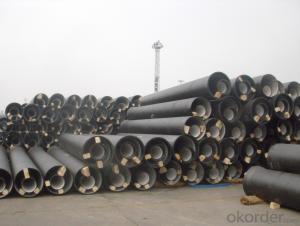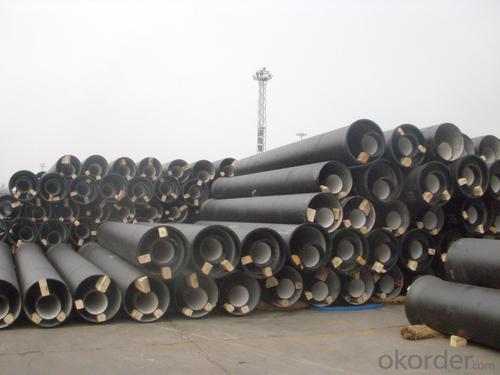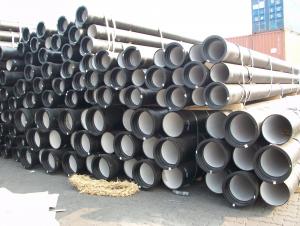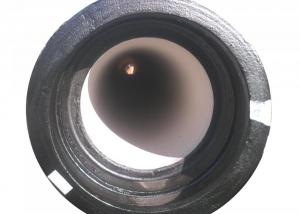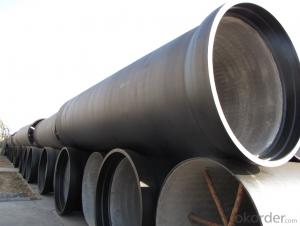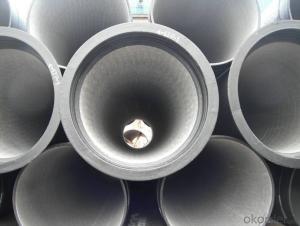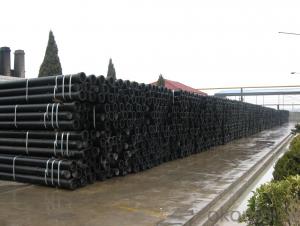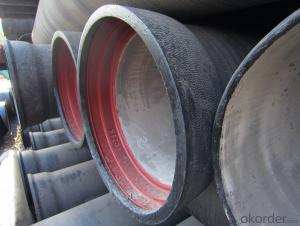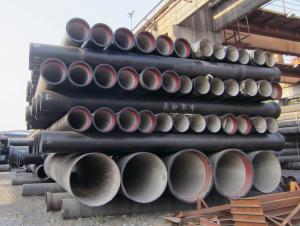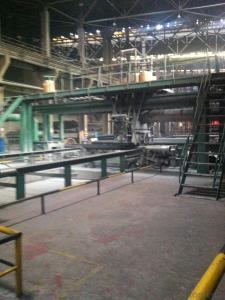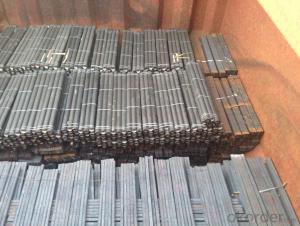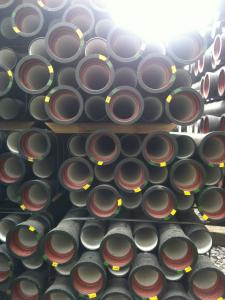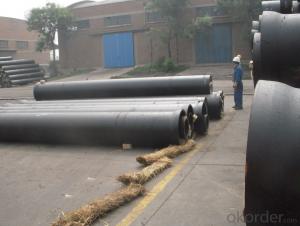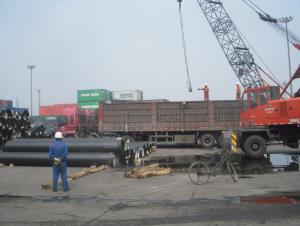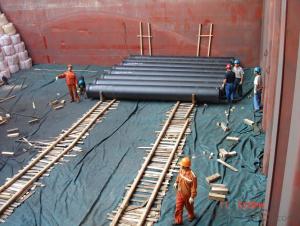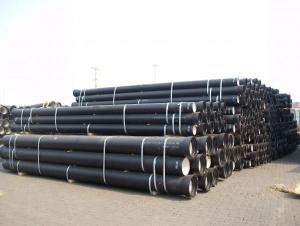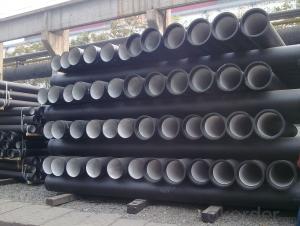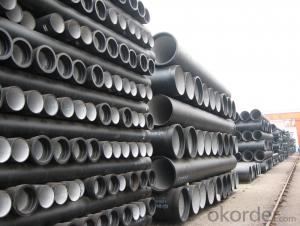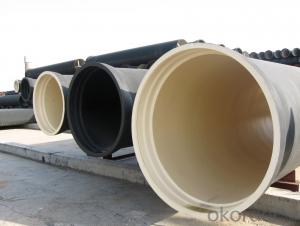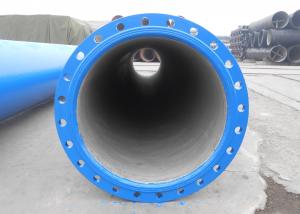DUCTILE IRON PIPES AND PIPE FITTINGS K8 CLASS DN500
- Loading Port:
- Tianjin
- Payment Terms:
- TT OR LC
- Min Order Qty:
- 22 pc
- Supply Capability:
- 3000 pc/month
OKorder Service Pledge
OKorder Financial Service
You Might Also Like
Material : Ductile Cast Iron
Size Range : DN 80mm to DN 2000mm
Unit Effective Length : 6m or 5.7m
Manufacture Standard: ISO 2531:1998/ EN 545:2006/EN 598:2007
Annual capacity : 200,000 tons
Coating Exterior: Zinc 130g/m2 according to ISO 8179-1 and bitumen coating 70 microns.
Cement Interior: Portland Cement/ High Alumina Cement/ Sulphate Resisting Cement Lining according to ISO 4179
Special requirements on external coating and internal lining can be applied
We also provide accessories such as SBR/EPDM rubber gaskets, lubricant paste, pipe caps, PE sleeves, etc.
Additional Parts:
Each pipe is strictly inspected according to related standard to ensure permanently high performance.
Easy Installation at site and service free for life
Long Service Lifespan
Quotation will arrive you within 24hours once we get your inquiry.
We guarantee offering you a competitive price.
A copy of original inspection reports of pipes will be offered after shipment.
Photos of loading process will be sent to the customer after shipment effect.
We will follow-up the delivery progress after shipment effect and update to the customer on weekly basis.
- Q: Steel plastic pipe, ductile iron pipe, steel pipe difference
- The utility model has the advantages of wide application range, more connecting modes, suitable for most occasions, good sealing property, proper material selection and anticorrosion treatment, and can greatly increase the corrosion resistance.
- Q: How do ductile iron pipes handle ground settlement?
- Ductile iron pipes are highly effective in handling ground settlement due to their inherent flexibility and resistance to deformation. The unique properties of ductile iron, including its high tensile strength and elongation capacity, make it an ideal material for withstanding ground movement. When ground settlement occurs, which is the downward movement of soil or sediment, ductile iron pipes have the ability to flex and adjust to the shifting ground without fracturing. The pipes can absorb the stress caused by the settlement and distribute it evenly along their length, minimizing the risk of cracks or breaks. Furthermore, ductile iron pipes are designed with a bell and spigot joint system, which allows for slight movement and rotation at the joints. This feature enables the pipes to accommodate ground settlement by absorbing any misalignment or shifting of the surrounding soil. Additionally, ductile iron pipes have a higher load-bearing capacity than other materials like PVC or HDPE. This means that they can withstand heavier loads and pressures from the surrounding soil, reducing the risk of pipe failure or collapse during ground settlement. In conclusion, ductile iron pipes are well-suited to handle ground settlement due to their flexibility, resistance to deformation, and ability to distribute stress evenly. Their unique properties ensure that they can withstand the challenges posed by shifting ground conditions, making them a reliable choice for underground infrastructure projects.
- Q: What is the expected deflection range for ductile iron pipes?
- The expected deflection range for ductile iron pipes can vary depending on several factors such as pipe diameter, wall thickness, soil conditions, and installation methods. Generally, ductile iron pipes have a higher deflection capacity compared to other materials like PVC or concrete pipes. For smaller diameter ductile iron pipes (up to 12 inches), the expected deflection range is typically around 2-3% of the pipe diameter. This means that a 12-inch ductile iron pipe could deflect up to approximately 0.24-0.36 inches. For larger diameter ductile iron pipes (greater than 12 inches), the expected deflection range can be slightly higher, ranging from 2-5% of the pipe diameter. This means that a 24-inch ductile iron pipe could deflect up to approximately 0.48-1.2 inches. It is important to note that these values are general estimates and should be verified with the manufacturer's specifications or engineering design guidelines for a specific project. Additionally, proper installation techniques and backfilling practices should be followed to ensure the pipe's structural integrity and prevent excessive deflection.
- Q: What are the disadvantages of using ductile iron pipe?
- There are several disadvantages associated with using ductile iron pipe. Firstly, one major drawback is its cost. Ductile iron pipe tends to be more expensive than other types of piping materials such as PVC or even traditional cast iron. This can make it less appealing for projects with strict budget constraints. Secondly, ductile iron pipe is relatively heavy compared to other materials. This makes it more difficult to handle and install, requiring specialized equipment and additional labor. The weight can also make it more susceptible to damage during transport and installation. Another disadvantage is its susceptibility to corrosion. While ductile iron is more resistant to corrosion than traditional cast iron, it is still prone to rust and deterioration over time. This can lead to reduced lifespan and potential leaks or pipe failures. Additionally, ductile iron pipe has limited flexibility and is not as resistant to ground movement or settlement. This can result in cracking or breaking of the pipe, especially in areas with unstable soil conditions or seismic activity. Lastly, ductile iron pipe can have a rough interior surface, which can lead to increased friction and reduced flow capacity. This can result in higher pumping costs and decreased efficiency in fluid transportation. Overall, while ductile iron pipe has its advantages, such as its strength and durability, these disadvantages should be carefully considered when choosing the appropriate piping material for a specific project.
- Q: What are the common methods for flow control in ductile iron pipes?
- There are several common methods for flow control in ductile iron pipes. One of the most commonly used methods is the installation of valves. Valves can be used to regulate the flow of water or other fluids through the pipes. They can be manually operated or automated, depending on the specific needs of the system. Another method for flow control in ductile iron pipes is the use of flow restrictors or flow limiters. These devices are installed in the pipes to reduce the flow rate and ensure that the system operates within its designed parameters. Flow restrictors can be useful in situations where the flow needs to be controlled to prevent damage or to optimize the efficiency of the system. Flow control can also be achieved through the use of pressure regulators. These devices are installed in the pipes to maintain a specific pressure level within the system. Pressure regulators can help prevent excessive pressure, which can lead to pipe bursts or other damage. They can also help maintain a consistent pressure throughout the system, ensuring that the flow is controlled and predictable. Additionally, flow control can be achieved through the use of flow meters. These devices are installed in the pipes to measure the flow rate of the fluid passing through them. By monitoring the flow rate, operators can adjust valves or other flow control devices to ensure that the flow is within the desired range. Flow meters are particularly useful in applications where accurate flow measurement is crucial, such as in industrial processes or water distribution systems. Overall, the common methods for flow control in ductile iron pipes include the use of valves, flow restrictors, pressure regulators, and flow meters. These methods can be combined or used individually depending on the specific requirements of the system.
- Q: DN300 what's the price of the ductile iron pipe / the weight and the price of one meter?
- Ductile iron pipe is a kind of cast iron. It is an alloy of iron, carbon and silicon.
- Q: What is the expected flow capacity of ductile iron pipes?
- The expected flow capacity of ductile iron pipes can vary depending on several factors such as the diameter and wall thickness of the pipe, the type of fluid being transported, and the specific design and condition of the pipeline system. Generally, ductile iron pipes are known for their high flow capacity due to their smooth internal surface which minimizes frictional losses. They are designed to handle a wide range of fluid flows, including water, sewage, and industrial fluids. In terms of specific flow rates, it is common to refer to the Manning's equation, which is widely used to calculate the flow capacity of open channels and pipes. This equation takes into account the hydraulic radius, slope of the pipe, and Manning's roughness coefficient to determine the expected flow capacity. However, it is important to note that the actual flow capacity can also be influenced by other factors such as the presence of fittings, valves, and bends in the pipeline, as well as any potential blockages or obstructions. Therefore, it is recommended to consult the manufacturer's specifications, engineering guidelines, or work with a qualified engineer to accurately determine the expected flow capacity of ductile iron pipes for a particular application.
- Q: Can ductile iron pipes be used for underground chemical transport systems?
- No, ductile iron pipes are not suitable for underground chemical transport systems as they are prone to corrosion and may react with certain chemicals, leading to potential leaks and contamination.
- Q: Usage of ductile iron pipe expander
- Spheroidal graphite iron expander, also known as cast iron telescopic device, is a new type of pipe connector.
- Q: Can ductile iron pipes be used for gas distribution networks?
- Yes, ductile iron pipes can be used for gas distribution networks.
Send your message to us
DUCTILE IRON PIPES AND PIPE FITTINGS K8 CLASS DN500
- Loading Port:
- Tianjin
- Payment Terms:
- TT OR LC
- Min Order Qty:
- 22 pc
- Supply Capability:
- 3000 pc/month
OKorder Service Pledge
OKorder Financial Service
Similar products
Hot products
Hot Searches
Related keywords
